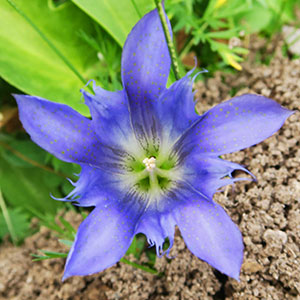Gentiana newberryi
Gentiana setigera
alpine gentian, Newberry's gentian
elegant gentian, Mendocino gentian
1–5, arising laterally below rosettes, from a stout tap root, tufted, decumbent.
1–12, arising laterally below rosettes, decumbent.
basal and cauline;
blades of basal rosette and proximal cauline leaf blades widely spatulate to obovate or oblanceolate, 0.8–5 cm × 2–25 mm, apex obtuse or mucronate, at least these leaves with blades less than 6 times as long as wide, distal cauline leaves few, with blades oblanceolate to lanceolate or linear, 2–5 cm × 2–5 mm, apices acute.
basal and cauline;
cauline leaves gradually more widely spaced distally;
basal and rosette blades spatulate-obovate, 2.5–8.5 cm × 5–15 mm, apex obtuse;
cauline blades elliptic, 1–3 cm × 5–17 mm, apex obtuse to acute.
terminal, flowers usually solitary, occasionally 2 or 3.
solitary flowers or 2–4-flowered heads.
calyx 14–30 mm, lobes linear to narrowly ovate, (4–)6–12 mm, margins not ciliate;
corolla white or blue, campanulate, open, 23–55 mm, lobes spreading, elliptic-obovate, 7–17 mm, free portions of plicae divided into 2 triangular, serrate to lacerate segments;
anthers distinct.
calyx 14–23 mm, lobes ovate-oblong, 5–8 mm, margins not ciliate;
corolla deep blue, campanulate, open, 25–50 mm, lobes elliptic-obovate, 10–16 mm, free portions of plicae divided nearly to base into 2 or 3 long, threadlike segments;
anthers distinct.
winged.
winged.
Gentiana newberryi
Gentiana setigera
Varieties 2 (2 in the flora).
The two varieties of Gentiana newberryi intergrade extensively. The most distinctive form of var. newberryi, with relatively tall stems and medium to deep blue corollas, occurs in the northern part of the range of the species, from the Klamath and White mountains of California north into Oregon. Plants most clearly referable to var. tiogana prevail in the southern part of the range of the species, from Butte County south to Inyo and Tulare counties, California. In the central part of the range of the species, plant size and corolla color are less consistently correlated, with occasional plants combining low stature with deep blue corollas or tall stems with predominantly white or pale blue corollas. In that part of the range, corolla color may be highly variable within a single population.
The leaves of Gentiana newberryi are thick-textured and distinctively concave, usually spoon-shaped, when fresh. Narrower leaves sometimes occur in var. tiogana, but many plants of that variety have widely spatulate leaves like those of var. newberryi.
(Discussion copyrighted by Flora of North America; reprinted with permission.)
Gentiana setigera is endemic to Gasquet Mountain, Del Norte County, and Red Mountain, Mendocino County, California, and a small area in Josephine County, Oregon. At the Oregon site, it has been called G. bisetaea or Waldo gentian. Reports from other sites have been based on G. plurisetosa, with which G. setigera has often been confused.
K. L. Chambers and J. Greenleaf (1989) and C. T. Mason (1991) distinguished Gentiana plurisetosa from G. setigera, clarified the nomenclature of G. setigera, and included G. bisetaea in G. setigera. Prior to those studies, all components of this complex had been of conservation concern. With G. plurisetosa comprising only a part of this complex, and with G. setigera now being more narrowly circumscribed, conservation concern remains appropriate for both of these species.
(Discussion copyrighted by Flora of North America; reprinted with permission.)
1. Corollas medium to deep blue with greenish to dark purple lines abaxially on and below lobes, usually 35–55 mm. | var. newberryi |
1. Corollas white to pale blue except for greenish to dark purple lines abaxially on and below lobes, usually 23–42 mm. | var. tiogana |


